Tested: 1990 Jeep Grand Wagoneer Versus Rivals
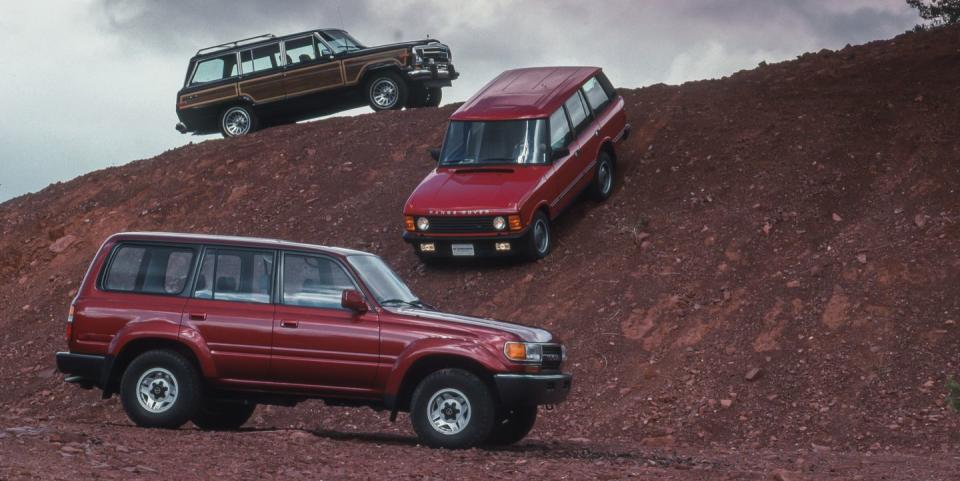
From the August 1990 issue of Car and Driver.
The problem with buying one of today's supercapable sport-utility vehicles—such as the Nissan Pathfinder or the Jeep Cherokee—is it makes so much sense that your neighbors are probably planning to do exactly the same thing. Modem SUVs are roomy, durable, and incredibly versatile. They'll make you forget you've been sitting at a desk all day and keep you from watching the World Wrestling Federation championships on Saturday. Everybody seems to want one.
Industry analysts predict that 800,000 people will fall for the nature-driver image and buy new SUVs this year. Many will never take their four-wheel-driver off road, but that's just fine: today's best SUVs arrow straight down the highway at noise levels as low as those of a Mazda 929 or an Audi 90 sedan. No wonder everybody wants in on the fun.
Such mass-market appeal spells trouble for the well-to-do, however. These folks want a four-wheel-drive wagon that is, well, distinctive. To the privileged, the Pathfinder and the Ford Explorer and the Chevy S-10 Blazer are commoner's vehicles, no matter how capable they are.
The three SUVs you see here are anything but common. Range Rover expects to sell only about 5000 examples of its $38,000 luxury SUV this year. Jeep will sell only about twice that number of $27,800 Grand Wagoneers. And Toyota will disperse a mere 6000 or so upscale Land Cruisers, which start at $22,000 but with obligatory luxuries come closer to $27,000. The proles are not likely to be seen in these expensive machines. Jeep's own research shows that the average Grand Wagoneer purchaser is richer than most Cadillac buyers.
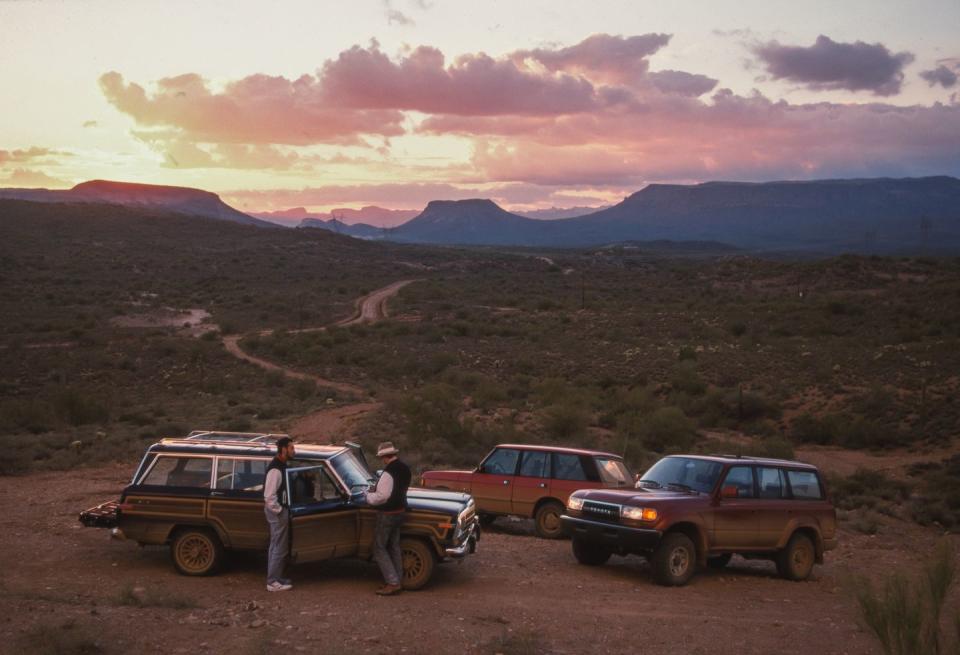
The three players we've assembled from this exclusive price class all employ four-wheel-drive systems that can be used full-time and robust live axles front and rear. All three have automatic transmissions—and only automatics; shifting is for the plebeians.
We ventured far and wide through a sometimes inclement Arizona winter to determine which of these three SUVs leads the luxury brigade. Without further ado, here's how they finished.
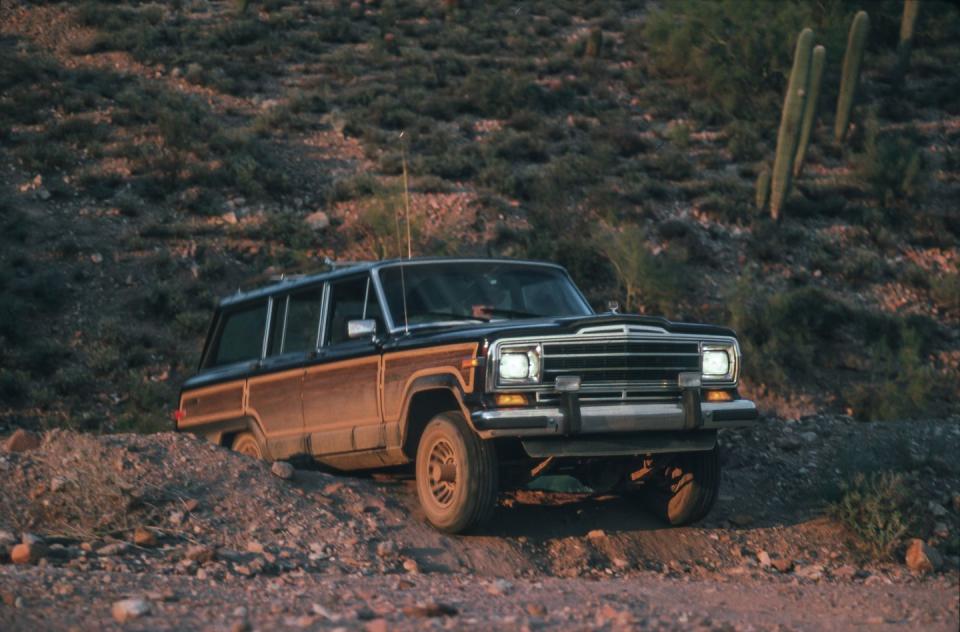
Third Place: Jeep Wagoneer
The Grand Wagoneer is the Alfa Spider of SUVs. It's a rolling, chrome-trimmed classic based on a design born when our president's name was Ike and color television was rare and exotic technology.
In 1963, a four-wheel-drive J100 Wagoneer cost $3332. Today, $29,059 buys that same six-passenger wagon, fully equipped and powered by a 5.9-liter V-8. The engine produces a mere 144 horsepower, a touch less than the Toyota Camry's 2.5-liter V-6. Still, its walloping 280 pound-feet of torque moves the 4500-pound Grand Wagoneer off the line smartly. From rest, the Jeep reaches 60 mph in 13.3 seconds—a reasonable showing, but 1.3 seconds slower than the 178-hp Range Rover. Nonetheless, the Grand Wagoneer is very stable at its 101-mph top speed, and it can out-corner the Range Rover and the Land Cruiser on dry pavement. Our test Jeep wore all-season street tires, which helped the vehicle's pavement handling.
The Grand Wagoneer is equipped with a full-time four-wheel-drive system whose center differential is fitted with a viscous coupling. The system can be shifted into two-wheel drive to improve fuel economy slightly. That could turn out to be important, because the EPA rates the Wagoneer at only 13 mpg on the highway, and we achieved just 12 mpg on our 500-mile trip—most of it done in four-wheel-drive mode. With its 20-gallon fuel tank, the Jeep offers a cruising range of only about 240 miles. The Range Rover can go about 60 miles farther on one tank; the Land Cruiser can outlast the Jeep by 100 miles or so.
The Wagoneer's four-wheel-drive system works very smoothly, but the leaf-spring suspension isn't so refined. The Jeep's live axles jump and bounce over washboard surfaces far more than those in the Range Rover or the Land Cruiser. And our test vehicle's hood shook badly on rough roads. One driver noted that the entire body of the vehicle shifted and jiggled side-to-side when the Wagoneer was pressed on irregular terrain.
These antics do little to improve your mood as you sit in the Wagoneer's driving environment. The seats are diabolical—holdovers from an era when all families had six members. Average family size changes, and so does back-support technology. The Jeep has not kept pace. The cabin's ergonomics leave much to wish for. The radio is mounted far from the driver, way down the instrument panel toward the glove box. It is difficult to reach and use. And the Jeep's climate-control system is woefully deficient—as we found out during a one-day drive that began in a morning snow-and-slush storm near the Grand Canyon and ended in Sunburn City near Phoenix. Mixing cabin air satisfactorily is particularly difficult; to defrost the window, you often have to endure cold feet.
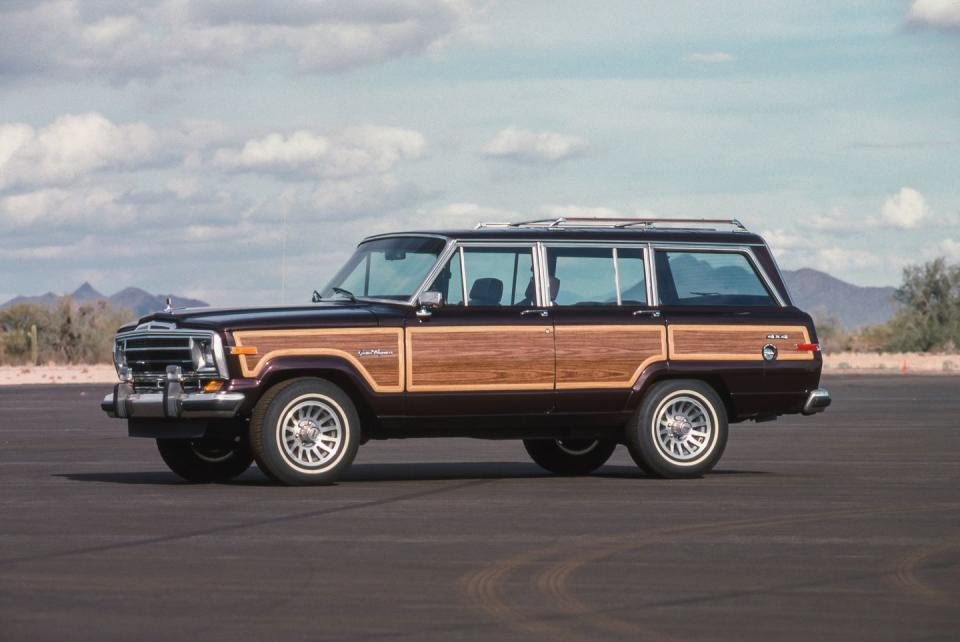
These operating frustrations would be bearable if the Jeep's V-8 drivetrain were more refined. The engine is carbureted, and firing it up on a cold morning brings back memories of how cars used to start twenty years ago. Once warm, however, the V-8 hums smoothly. The engine's massive torque allows it to work well with the three-speed automatic transmission—until you reach highway speeds. Above 75 mph, the engine is noisy.
Where the Grand Wagoneer shines is on twisty pavement. It displays confident, balanced handling on the skidpad and on the road. Indeed, on dry pavement the Grand Wagoneer feels almost like a car—a 1978 AMC Matador, perhaps, but still a car.
1990 Jeep Grand Wagoneer
144-hp V-8, 3-speed automatic, 4530 lb
Base/as-tested price: $27,795/$29,059
C/D TEST RESULTS
60 mph: 13.3 sec
1/4 mile: 19.2 @ 72 mph
Braking, 70–0 mph: 213 ft
Roadholding, 300-ft-dia skidpad: 0.70 g
C/D observed fuel economy: 12 mpg
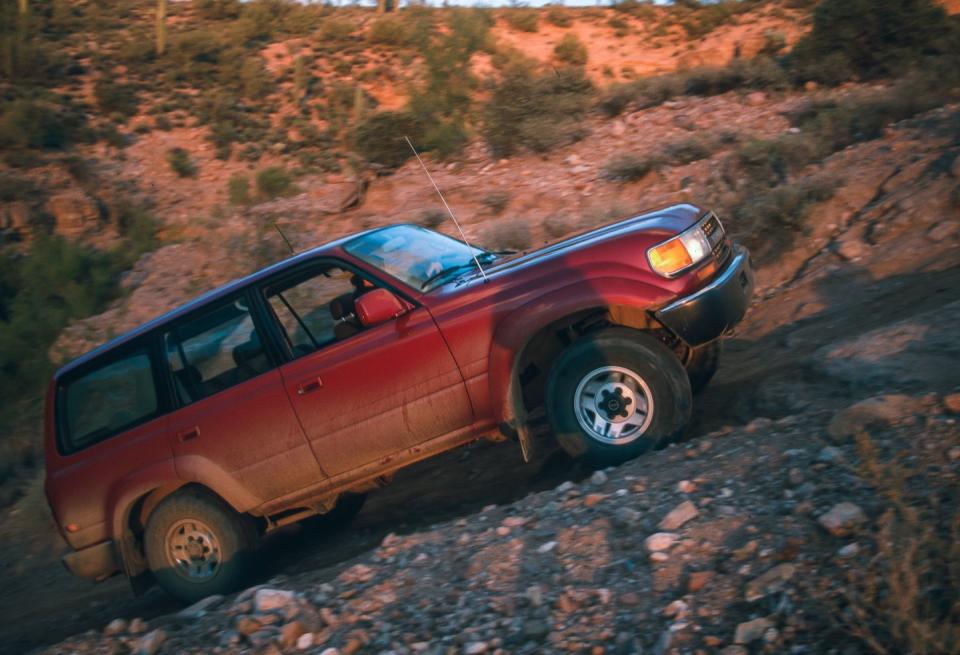
Second Place: Toyota Land Cruiser
To us, the new-for-1990 Land Cruiser doesn't offer as much value as Toyota's smaller 4Runner, an SUV that we like a lot. The Cruiser costs nearly $27,000 with options, about $1300 more than a fully decked-out 4Runner. Still, the Land Cruiser is roomier, and it has a full-time four-wheel-drive system. (The 4Runner offers part-time four-wheel drive only.)
Although we see the V-6–powered 4Runner as the better value, Toyota sees it as simply a pickup-based hybrid for U.S. drivers. The Land Cruiser, on the other hand, is the maker's serious off-road vehicle for the rest of the world—the SUV that every safari leader in Tanzania lusts after.
That philosophy explains some of the features that don't work on safari here in the United States—namely, the engine. The Land Cruiser's carried-over 4.0-liter straight-six is in use in well over a dozen countries on five continents. Its primary mission is to be durable—to run forever on bad fuel and good luck.
Designed for regions where engines are never revved beyond 2000 rpm, the Land Cruiser's six gets rough and noisy when pushed on U.S. Interstates. And the engine's moderate 155-hp output, combined with the Cruiser's 4823-pound weight, means that acceleration is poorer than the Jeep's or the Range Rover's. The lack of power also causes objectionable hunting between third and fourth gears when the vehicle slows on highway hills. We were able to improve things somewhat by leaving the automatic locked in third gear (our technical director flagellates test drivers who do this, because it increases fuel consumption), but we'd have preferred an optional manual transmission.
Despite the engine's shortcomings, the Land Cruiser is a fine cross-country vehicle—thanks to its neatly tailored cabin and highly refined suspension. The seats are up to the same high standards as in Toyota's cars, and the control layout, the ergonomics, and the cockpit space are tops in this class.
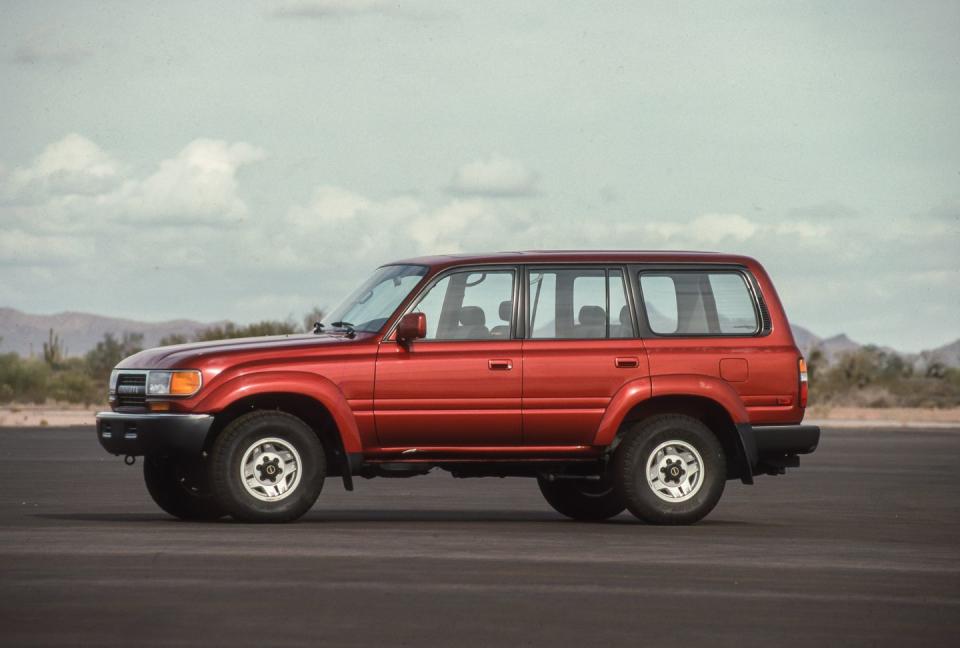
Our only criticism of the interior is the abundance of vacant switch locations on the instrument panel—eight in all. Evidently Toyota believes that these blank spaces will come in handy when adding switches for fog lights, air compressors, winches, trailer lights, and other accouterments of the complete camper.
In all, the new Cruiser is a versatile and remarkably car-like machine. Grandma would be happy to ride to church in one.
1990 Toyota Land Cruiser
155-hp 6-inline, 4-speed automatic, 4823 lb
Base/as-tested price: $21,998/$26,983
C/D TEST RESULTS
60 mph: 14.1 sec
1/4 mile: 19.6 @ 70 mph
Braking, 70–0 mph: 227 ft
Roadholding, 300-ft-dia skidpad: 0.68 g
C/D observed fuel economy: 14 mpg
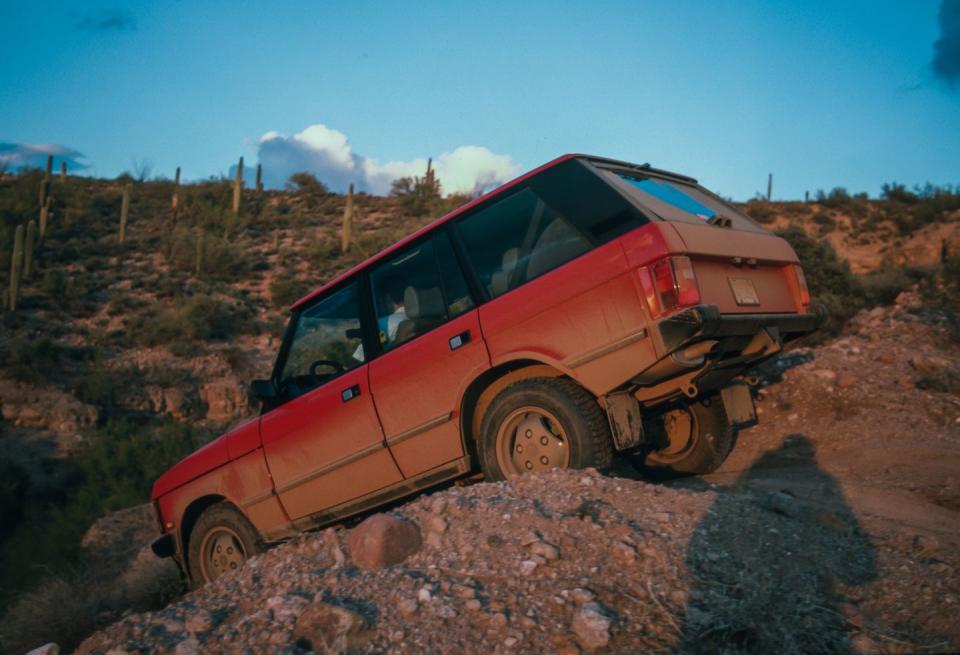
First Place: Range Rover
By a small margin, the Range Rover is the class of this field. Our test vehicle's $39,950 price hurt it in the value rating, but the RR makes up for that disadvantage with its overall refinement and exceptional off-road abilities.
The Range Rover is comfortable and fun to drive. Its aluminum V-8 is the most powerful engine in this group, and it revs smoothly. There is no driveline vibration at any speed. The four-speed automatic shifts cleanly and directly, and its ratios are perfectly spaced. We found no condition—from storm-socked freeways to billy-goat trails—that had us wishing for different gears.
It's clear that much attention has been paid to the Range Rover's suspension. Ample wheel travel is the key to outback comfort, and the Rover supplies wheel travel galore. We were seduced by the Range Rover's smooth ride. This would be our first SUV choice for a cross-country journey.
Somehow, the interior has escaped such attention. Though it is trimmed in soft leather and looks luxurious, the cabin is marred by jutting instrument-panel pieces, an awkward steering wheel, and bizarre seat-angle adjustments. The electric adjusters can move the front seats into positions that only make sense for napping on the south slope of Mount McKinley.
The Rover is about a foot shorter than both the Jeep and the Toyota, so it can carry only four passengers comfortably (five will fit in a pinch). The wheelbase is also shorter than in the other wagons, but this helps the Range Rover's maneuverability on off-road trails. (The short wheelbase makes the Range Rover's smooth ride all the more remarkable.)
The Rover has commendable road manners, though on the skidpad it lacks the lateral acceleration of the other two luxovehicles. It also felt the most susceptible to crosswinds and truck wash on the freeway, forcing us to make numerous small corrections of the steering to maintain the desired heading.
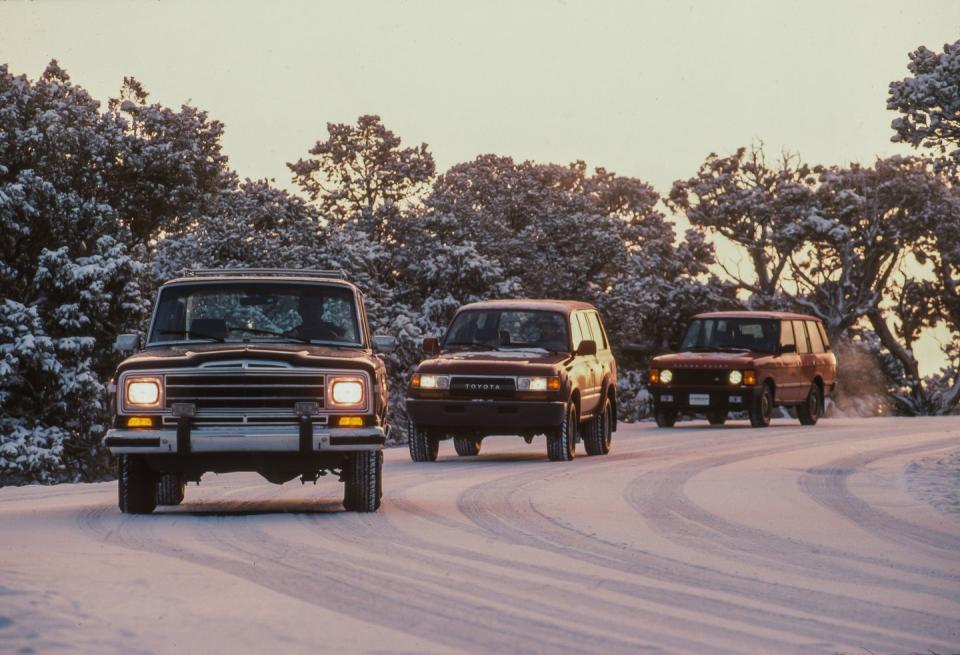
Fortunately, the steering is both light and direct, and corrections are easy to make. Because the Range Rover is sprung softly—to use its abundant wheel travel—it displays a lot of body roll on paved corners and inclined slopes alike. At first this feeling is unnerving. But it doesn't affect the performance of the Range Rover, and in time you learn to trust the vehicle's exaggerated body motions.
Trust us: there's a lot to like here.
1990 Land Rover Range Rover
178-hp V-8, 4-speed automatic, 4473 lb
Base/as-tested price: $38,025/$39,950
C/D TEST RESULTS
60 mph: 12.0 sec
1/4 mile: 18.5 @ 74 mph
Braking, 70–0 mph: 210 ft
Roadholding, 300-ft-dia skidpad: 0.63 g
C/D observed fuel economy: 15 mpg
All three of these luxury all-terrain vehicles can handle far more than most of us will ever dish out. Their practicality is limited only by relatively poor fuel mileage and high prices. But the high cost of entering this SUV realm isn't keeping buyers out—indeed, the luxury-SUV niche is growing. Laforza (C/D, June 1989) has launched a fully equipped, $43,000 competitor to the Range Rover (unfortunately, no Laforza was available at the time of our test). And this fall Isuzu will unveil its next-generation, V-8- powered Trooper in the U.S.
So expect to see more and more of these big, expensive wagons roaming through Shenandoah and Yosemite parks. And, Tenley, pass the Grey Poupon, would you, dear?
You Might Also Like

 Yahoo Autos
Yahoo Autos 